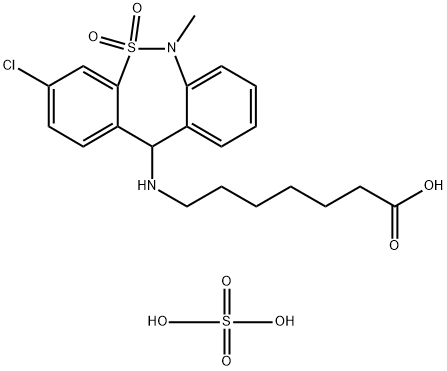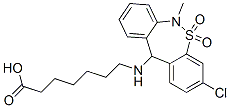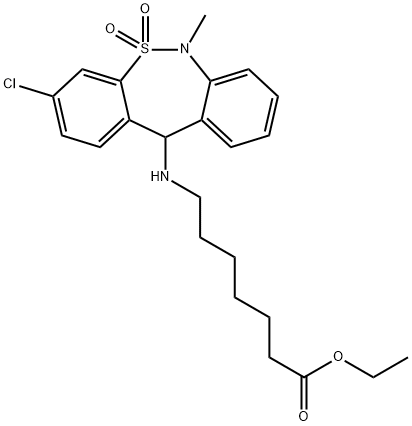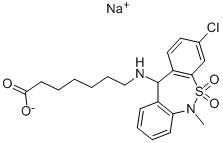tianeptine sulfate
- CAS NO.:1224690-84-9
- Empirical Formula: C21H27ClN2O8S2
- Molecular Weight: 535.02
- EINECS: 200-001-8
- Update Date: 2024-12-06 22:41:32

What is tianeptine sulfate?
Physical properties
Tianeptine sulfate is more stable than tianeptine sodium which is notoriously unstable; it reacts to both atmospheric moisture and to light. Tianeptine sulfate on the other hand does not absorb the water from air so it does not clump.Tianeptine sulfate is soluble and cam be mixed easily with water.
The Uses of tianeptine sulfate
Tianeptine sulfate is classified as a selective serotonin reuptake enhancer (SSRE) used to treat depression. Tianeptine was developed in France in the 1960s and has been used throughout the last part of the 2000s. Tianeptine sulfate improves brain neuroplasticity and decreases depression. Neuroplasticity is the brain’s ability to adapt and change when learning; contributing to better cognitive performance and improved learning ability.
Definition
Tianeptine is used as a prescription drug in some European, Asian, and Latin American countries, but it is not approved as a drug in the United States. The FDA is aware of several serious adverse event reports associated with tianeptine. Tianeptine is also known as: Tianeptine sulfate, Tianeptine sodium powder, Tianaa, Tianna Green, Tianna Red, and Tianna White.
What are the applications of Application
Tianeptine sulfate can be used to provide pharmaceutical compositions for the treatment of conditions known in the art, such as one or more depressive disorders, irritable bowel syndrome (IBS), attention deficit hyperactivity disorder (ADHD), one or more neurodegenerative diseases, and asthma.
Pharmacokinetics
The effect tianeptine sulfate lasts longer than tianeptine sodium. Tianeptine sulfate is absorbed by the body slowly so its effect is also extended and that means less dosing.
Side Effects
Tianeptine is prescribed as an antidepresant in Europe. The prescription drug is produced as tianeptine sodium. The most common adverse effects of Tianeptine are nausea, constipation, abdominal pain, headache, dizziness and changes in dreaming. Anticholinergic effects occur less often with tianeptine than with tricyclic agents. Hepatoxicity is rare.
Properties of tianeptine sulfate
Safety information for tianeptine sulfate
Computed Descriptors for tianeptine sulfate
| InChIKey | KVVMXNNJBVTOSX-UHFFFAOYSA-N |
New Products
4-Fluorophenylacetic acid 4-Methylphenylacetic acid N-Boc-D-alaninol N-BOC-D/L-ALANINOL Tert-butyl bis(2-chloroethyl)carbamate 3-Morpholino-1-(4-nitrophenyl)-5,6-dihydropyridin- 2(1H)-one Furan-2,5-Dicarboxylic Acid Tropic acid S-2-CHLORO PROPIONIC ACID ETHYL ISOCYANOACETATE 2-Bromo-1,3-Bis(Dimethylamino)Trimethinium Hexafluorophosphate (6-METHYL-[1,3]DITHIOLO[4,5-b]QUINOXALIN-2-ONE INDAZOLE-3-CARBOXYLIC ACID 4-IODO BENZOIC ACID (2-Hydroxyphenyl)acetonitrile 4-Bromopyrazole 5,6-Dimethoxyindanone 2-(Cyanocyclohexyl)acetic acid 4-methoxy-3,5-dinitropyridine 2-aminopropyl benzoate hydrochloride 1-(4-(aminomethyl)benzyl)urea hydrochloride diethyl 2-(2-((tertbutoxycarbonyl)amino) ethyl)malonate tert-butyl 4- (ureidomethyl)benzylcarbamate Ethyl-2-chloro((4-methoxyphenyl)hydrazono)acetateRelated products of tetrahydrofuran
You may like
-
 2033-24-1 98%View Details
2033-24-1 98%View Details
2033-24-1 -
 42831-50-5 5-METHYLISOXAZOLE-4-CARBOXYLIC ACID 98%View Details
42831-50-5 5-METHYLISOXAZOLE-4-CARBOXYLIC ACID 98%View Details
42831-50-5 -
 1975-50-4 98%View Details
1975-50-4 98%View Details
1975-50-4 -
 2-HYDROXY BENZYL ALCOHOL 98%View Details
2-HYDROXY BENZYL ALCOHOL 98%View Details
90-01-7 -
 2-Chloro-1,3-Bis(Dimethylamino)Trimethinium Hexafluorophosphate 221615-75-4 98%View Details
2-Chloro-1,3-Bis(Dimethylamino)Trimethinium Hexafluorophosphate 221615-75-4 98%View Details
221615-75-4 -
 61397-56-6 CIS BROMO BENZOATE 98%View Details
61397-56-6 CIS BROMO BENZOATE 98%View Details
61397-56-6 -
 14714-50-2 (2-Hydroxyphenyl)acetonitrile 98+View Details
14714-50-2 (2-Hydroxyphenyl)acetonitrile 98+View Details
14714-50-2 -
 118753-70-1 98+View Details
118753-70-1 98+View Details
118753-70-1


